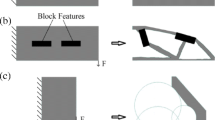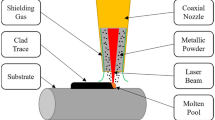Abstract
In this paper, a new equidistant filling theory based on the level set function and a corresponding numerical algorithm based on the dynamic finite difference method were proposed. Firstly, a closed curve is defined as the zero-value contour of the level set function. Then, the level set equation, a partial differential equation, was built to get the level set function, and a dynamic finite difference method was proposed to solve the level set function. Secondly, three types of cross sections, simple polygon, multi-island polygon, and multi-hole polygon, were used to test the equidistant filling effect of the algorithm. The test results show that the proposed theory and algorithm in this paper solved the equidistant filling problem of these cross sections well. In addition, any complex section can be equidistant filled by the algorithm proposed. The calculation cost is significantly related to the number of the offsets, but not directly related to the section complexity. Finally, the remanufacturing of a typical crankshaft hot forging die proves that the algorithm proposed in this paper can effectively produce the remanufacturing repair path of a complex forging die. The surface of the remanufactured die is smooth, and there is no efects such as porosity and slag inclusion after machining. Compared with making a new die, the manufacturing cost can be saved more than 50%, and the efficiency of die manufacturing can be improved more than 60%. This is because the machining allowance of the die after additive manufacturing is very small, and it can be quickly repaired on site.















Similar content being viewed by others
Data availability
All data generated or analyzed during this study are included in this published article.
References
Ding D, Pan Z, Cuiuri D, Li H (2015) A practical path planning methodology for wire and arc additive manufacturing of thin-walled structures. Robot Comput Integr Manuf 34(8): 8–19
Singh S, Sharma SK, Rathod DW (2021) A review on process planning strategies and challenges of WAAM. Mater Today: Proc 2021(4)
Yaseer A, ChenH (2021) A review of path planning for wire arc additive manufacturing (WAAM). J Adv Manuf Syst
Karunakaran KP, Suryakumar S, Pushpa V, Akula S (2010) Low cost integration of additive and subtractive processes for hybrid layered manufacturing. Robot Comput Integr Manuf 26(5):490–499
Farouki RT, Koenig T, Tarabanis KA, Korein JU, Batchelader JS (1995) Path planning with offset curves for layered fabrication processes. J Manuf Syst 14(5):355–368
Yang Y, Loh HT, Fuh J, Wang Y (2002) Equidistant path generation for improving scanning efficiency in layered manufacturing. Rapid Prototyp J 8(1):30–37
Li H, Dong Z, Vickers GW (1994) Optimal toolpath pattern identification for single island, sculptured part rough machining using fuzzy pattern analysis. Comput Aided Des 26(11):787–795
Dunlavey MR (1983) Efficient polygon-filling algorithms for raster displays. ACM Trans Graph 2(4):264–273
Park SC, Choi BK (2000) Tool-path planning for direction-parallel area milling. Comput Aided Des 32(1):17–25
Wang H, Jang P, Stori JA (2001) A metric-based approach to two-dimensional (2D) tool-path optimization for high-speed machining. Am Soc Mech Eng
Kulkarni P, Marsan A, Dutta D (2000) A review of process planning techniques in layered manufacturing. Rapid Prototyp J 6(1):18–35
Konrad C (2011) Two-constraint domain decomposition with space filling curves. Parallel Comput 37(4–5):203–216
Dwivedi R, Kovacevic R (2004) Automated torch path planning using polygon subdivision for solid freeform fabrication based on welding. J Manuf Syst 23(4):278–291
Rajan VT, Srinivasan V, Tarabanis KA (2001) The optimal zig-zag direction for filling a two dimensional region. Rapid Prototyp J 7(5):231–241
Park SC, Choi BK (2000) Tool-path planning for direction-parallel area milling. Comput Aided Des 32(1):17–25
Sang CP, Yun CC, Choi BK (2003) Contour-parallel offset machining without tool-retractions. Comput Aided Des 35(9):841–849
Mao L, Gao F, Yuan Z, Chen X, Benke WU (2017) Filling algorithm of two-dimensional contour in selective laser melting molding. J Hefei Univ Technol
Sethian JA (1999) Level set methods and fast marching method. J Comput Inf Technol 11(1)
Adalsteinsson D, Sethian JA (1995) A fast level set method for propagating interfaces. J Comput Phys 118 2
Osher S, Sethian JA (1988) Fronts propagating with curvature-dependent speed: algorithms based on Hamilton-Jacobi formulations. J Comput Phys 79(1):12–49
Crandall M, Lions PL (1983) Viscosity solutions of Hamilton-Jacobi equations. Trans Am Math Soc 277(1):1–42
Funding
This research is supported by National Natural Science Foundation of China (No. 52075058) and by Postdoctoral Science Foundation of Chongqing Natural Science Foundation (No. cstc2020jcyj-bshX0006).
Author information
Authors and Affiliations
Contributions
Xiaoying Hong put forward the relevant algorithm and ideas and wrote the article. Guiqian Xiao wrote the software and developed the hardware and carried out experiments. Yancheng Zhang did the welding process parameter experiment. Jie Zhou guided and reviewed the whole process.
Corresponding author
Ethics declarations
Ethics approval
Not applicable.
Consent to participate
Not applicable.
Competing Interests
The authors declare no competing interests.
Additional information
Publisher's Note
Springer Nature remains neutral with regard to jurisdictional claims in published maps and institutional affiliations.
I would like to declare on behalf of my co-authors that the work was an original research that has not been published previously.
Rights and permissions
About this article
Cite this article
Hong, X., Xiao, G., Zhang, Y. et al. A new path planning strategy based on level set function for layered fabrication processes. Int J Adv Manuf Technol 119, 517–529 (2022). https://doi.org/10.1007/s00170-021-08239-0
Received:
Accepted:
Published:
Issue Date:
DOI: https://doi.org/10.1007/s00170-021-08239-0




